Supermicro presented us with the Hyper SuperServer SYS-212HA-TN, a system advertised as a versatile 2U server tailored for enterprise-grade scalability and performance. Featuring the Intel® Xeon® 6 6900 series processors, this server is promoted as capable of excelling in a broad range of workloads, including virtualization, AI inference, machine learning, software-defined storage, cloud computing, database management, and high-density storage. This review will explore how well it delivers its promise of versatility and high performance in real-world scenarios.
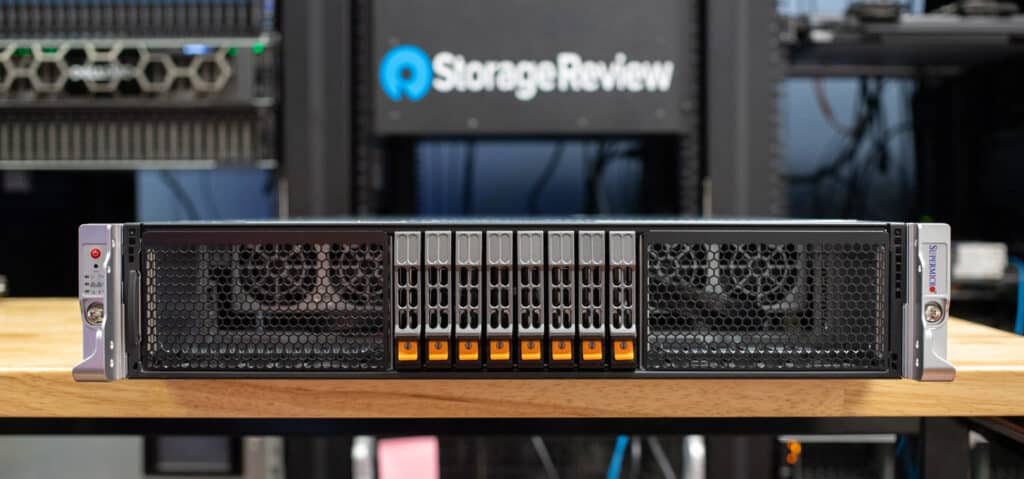
Supermicro Hyper SuperServer SYS-212HA-TN Specifications
| Category | Details |
|---|---|
| Product SKUs | SuperServer SYS-212HA-TN |
| Motherboard | Super X14SBH-AP |
| Processor | Single Socket BR (LGA-7529), Intel® Xeon® 6900 series processors with P-cores, Up to 128C/256T, Up to 504MB Cache, Supports up to 500W TDP CPUs (Air Cooled) |
| System Memory | Slot Count: 12 DIMM slots, Max Memory (1DPC): Up to 3TB 8800MT/s ECC DDR5 MRDIMM, Up to 3TB 6400MT/s ECC DDR5 RDIMM, Memory Voltage: 1.1V |
| On-Board Devices | NVMe RAID 0/1/5/10 support (Intel® VROC RAID key required), System on Chip, Network Connectivity via AIOM |
| Input / Output | LAN: 1 RJ45 1 GbE Dedicated BMC LAN port, USB: 2 USB 3.2 Gen1 ports (Rear), Video: 1 VGA port |
| System BIOS | AMI 64MB SPI Flash |
| Management | SuperCloud Composer, Supermicro Server Manager (SSM), Super Diagnostics Offline (SDO), Supermicro Thin-Agent Service (TAS), SuperServer Automation Assistant (SAA) |
| Security | TPM 2.0, Silicon Root of Trust (RoT), Cryptographically Signed Firmware, Secure Boot, Automatic Firmware Recovery |
| Chassis | 2U Rackmount, CSE-HS201-R000NFP |
| Dimensions and Weight | Height: 3.5″ (88.9 mm), Width: 17.2″ (437 mm), Depth: 31.74″ (806.2 mm), Gross Weight: 75 lbs (34 kg), Net Weight: 45 lbs (20.5 kg) |
| Front Panel | LED: HDD activity, LAN1 activity, Power status, System information, Buttons: Power On/Off, UID button |
| Expansion Slots | Option A: 1 PCIe 5.0 x16, 1 PCIe 5.0 x8, 1 PCIe 5.0 x16 double-width, 1 PCIe 5.0 x16 AIOM slot; Option B: 2 PCIe 5.0 x8, 1 PCIe 5.0 x8 HHFL, 1 PCIe 5.0 x16 double-width, 1 PCIe 5.0 x16 AIOM slot |
| Drive Bays / Storage | 8 front hot-swap 2.5″ NVMe*/SAS*/SATA* drive bays, Option A: 24 front hot-swap 2.5″ SAS*/SATA* drive bays, 2 M.2 NVMe slots |
| System Cooling | 6 counter-rotating 60x60x56mm fans |
| Power Supply | 2x 1200W, 1300W, 1600W, 2000W, 2600W Redundant Titanium Level power supplies |
| Operating Environment | Operating Temperature: 10°C ~ 35°C, Non-operating Temperature: -40°C to 70°C, Operating Relative Humidity: 8% to 90% |
Supported CPU Configurations
This server supports Intel Xeon 6th Generation (Granite Rapids) processors, which are optimized explicitly for P-SKU CPUs. It fully utilizes the performance-focused P-cores for enhanced compute power. Unlike the Hyper SuperServer 1U 112H-TN, which was previously reviewed and supports the Intel Xeon 6th Generation (Sierra Forest) E-core SKUs, this chassis is tailored for P-SKU processors, ensuring maximum performance from the P-core architecture.
Below is the list of compatible CPUs for this unit:
| SKU | Cores / Threads | Base Frequency (GHz) | All Core Turbo (GHz) | Max Turbo (GHz) | TDP (Watts) | Cache (MB) | Maximum Scalability | DDR5 Memory Speed | MRDIMM Memory Speed |
|---|---|---|---|---|---|---|---|---|---|
| 6980P | 128 | 2.0 | 3.2 | 3.9 | 500 | 504 | 2S | 6400 | 8800 |
| 6979P | 120 | 2.1 | 3.2 | 3.9 | 500 | 504 | 2S | 6400 | 8800 |
| 6972P | 96 | 2.4 | 3.5 | 3.9 | 500 | 480 | 2S | 6400 | 8800 |
| 6952P | 96 | 2.1 | 3.2 | 3.9 | 400 | 480 | 2S | 6400 | 8800 |
| 6960P | 72 | 2.7 | 3.8 | 3.9 | 500 | 432 | 2S | 6400 | 8800 |
Memory
This server is designed for high-performance workloads and supports up to 12 populated DIMM slots, allowing for a maximum memory capacity of 3TB when configured with 1DPC. It delivers exceptional performance with support for ECC DDR5 MRDIMMs at speeds of up to 8800MT/s or ECC DDR5 RDIMMs at up to 6400MT/s, making it ideal for high-performance and memory-intensive applications.
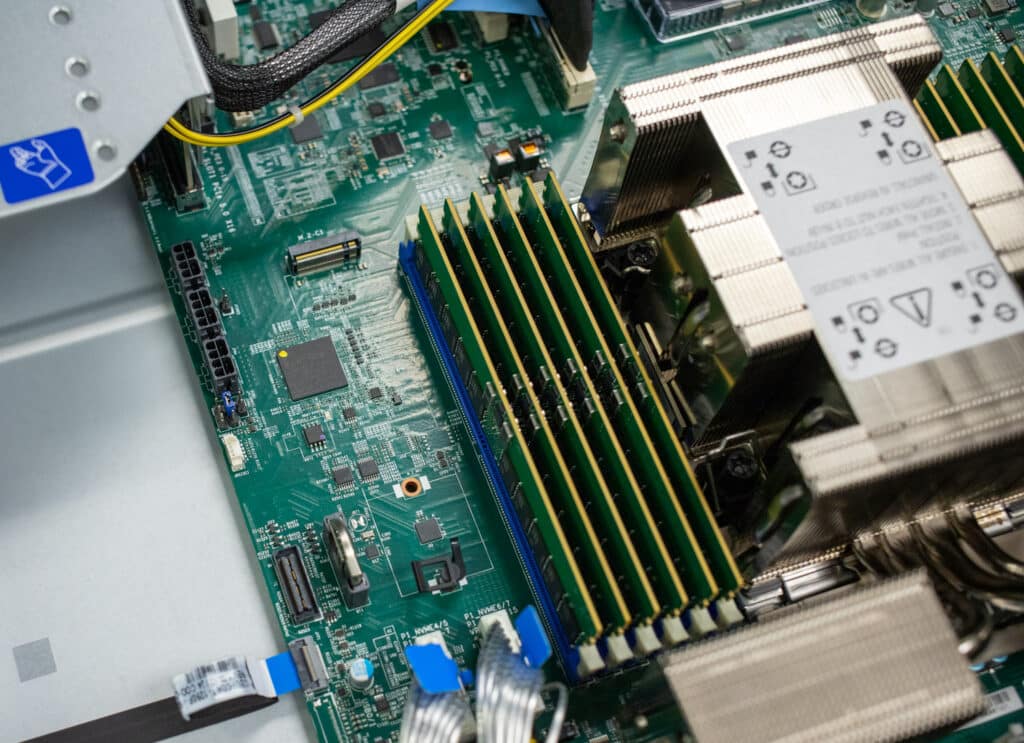
Storage
Regarding storage, this server offers versatile configurations to meet various application needs. By default, it supports eight front hot-swap 2.5″ NVMe/SAS/SATA drive bays, delivering high-speed storage capabilities. The system expands to 24 bays for Larger storage demands. Additionally, the system includes two M.2 NVMe slots (M-key 2280/22110/25110) for high-performance SSDs, with VROC required for RAID setups. As detailed in the optional parts list, specific configurations may require additional storage controllers or cables. This flexibility ensures scalability and adaptability for diverse storage requirements. There’s no EDSFF support today, but the configuration page leads us to believe that Supermicro could offer more drive form factor support in the future.
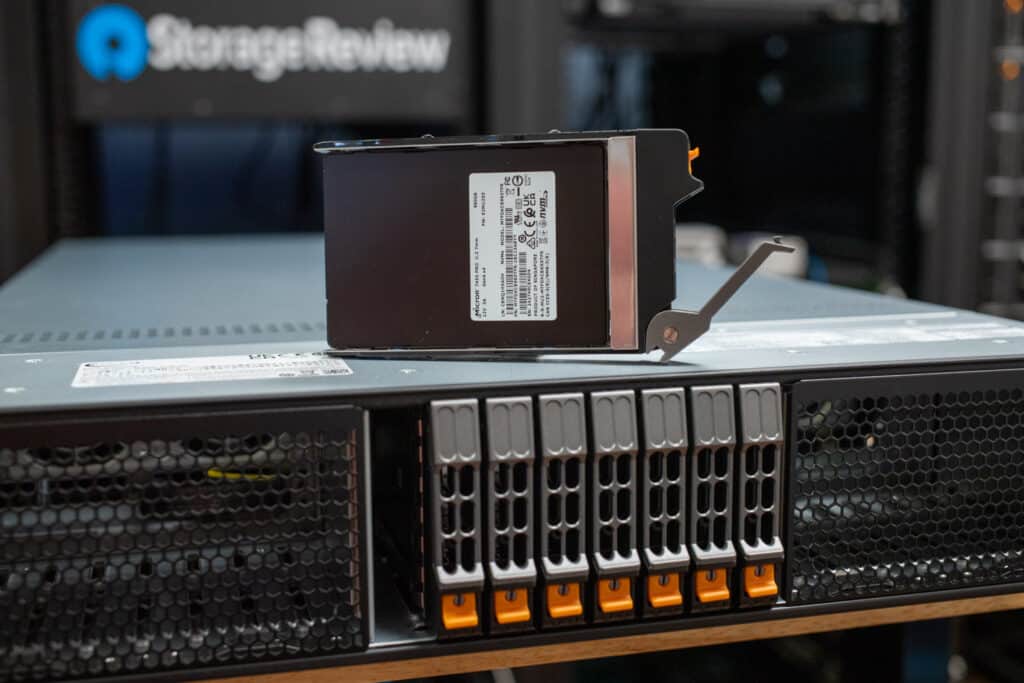
Networking
The SYS-212HA-TN has one PCIe 5.0 x16 AIOM slot (OCP 3.0 compatible) for network interface cards. It also offers expansion options such as 1 PCIe 5.0 x16 FH/10.5″ L double-width slot, 1 PCIe 5.0 x8 FHFL slot, and 1 PCIe 5.0 x16 HHFL double-width slot. This flexibility enables seamless integration of high-bandwidth networking solutions to meet the demands of cloud, AI, and other data-heavy applications.
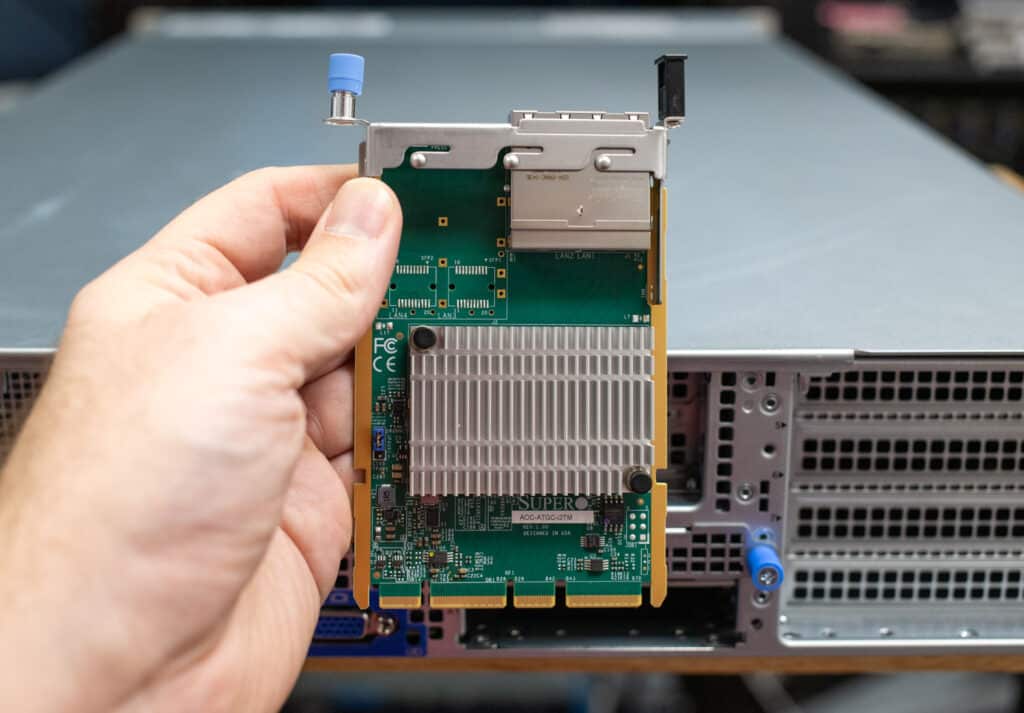
Power
To ensure maximum reliability and uptime, Supermicro is offering server configurations with 2x 1+1 redundant power supplies for enhanced reliability and uptime. These power supplies range from 1200W to 2000W and support input ranges of 120V/240V AC or -44 to -65V DC, accommodating various application needs. Available in both Titanium Level (96%) and Gold Level efficiency ratings, they provide excellent energy performance, balancing operational efficiency and cost-effectiveness for diverse workloads.
Supermicro Hyper SuperServer SYS-212HA-TN Build and Design
The SYS-212HA-TN is a standard 2U rackmount designed for typical server environments while maintaining a compact profile. Its dimensions measure 3.5″ (88.9 mm) in height, 17.2″ (437 mm) in width, and 31.74″ (806.2 mm) in depth, ensuring compatibility with standard server racks. The package dimensions are 9.96″ (H) x 26.46″ (W) x 43.31″ (D), and the unit weighs 45 lbs (20.5 kg) net, with a gross shipping weight of 75 lbs (34 kg). Built with a practical silver chassis, complemented by a black front panel and a traditional Supermicro rack ear design
Front Panel
On the unit’s front panel, you’ll find several LED indicators, including HDD activity, LAN1 activity, power status, and system information, providing critical status updates at a glance. The panel also features a power and UID button for system identification. The default configuration includes eight front hot-swap 2.5″ drive bays that support NVMe, SAS, or SATA drives, making it ideal for high-speed and flexible storage solutions. Additionally, an optional configuration expands the unit to 24 front hot-swap 2.5″ SAS or SATA drive bays. Supermicro did not include USB or display connectivity options on the front panel, keeping the design streamlined for storage and management.
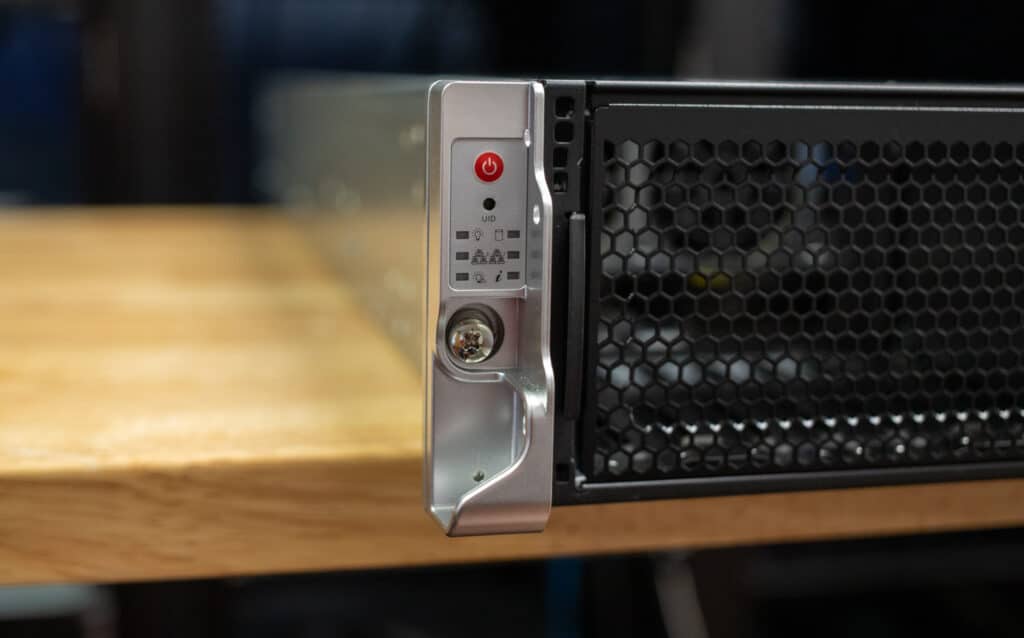
Rear Panel
On the rear of the unit, you’ll find a VGA port for video output, a dedicated BMC LAN port for out-of-band management, and two USB 3.2 Gen 1 ports for peripheral connectivity. Two hot-swap redundant power supplies ensure uninterrupted operation.
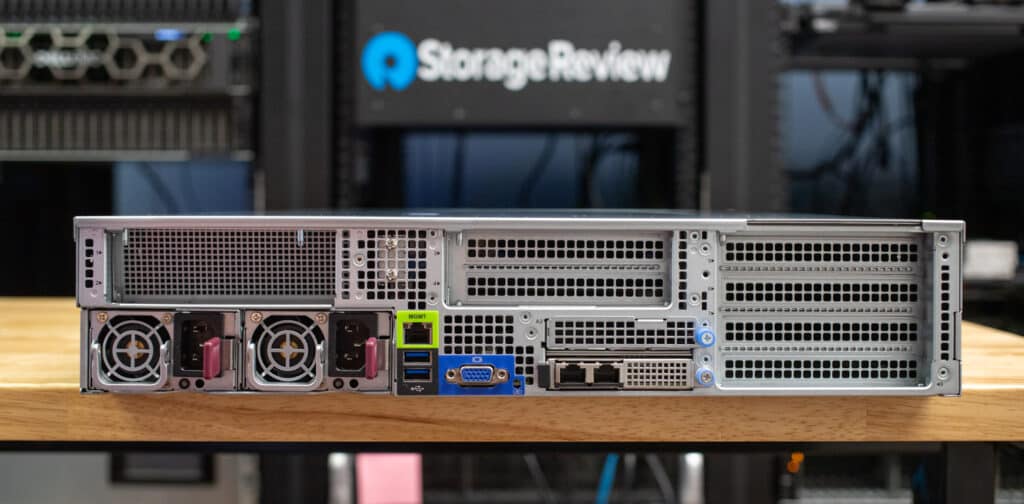
For expansion, it offers multiple PCIe 5.0 slots, including a PCIe 5.0 x16 full-height, 10.5-inch-long double-width slot; a PCIe 5.0 x8 full-height, full-length slot; a PCIe 5.0 x16 half-height, full-length double-width slot; and a PCIe 5.0 x16 AIOM slot that is OCP 3.0 compatible. These slots support many add-ons, such as networking cards, GPUs, and other high-performance components.
Internal
The Super X14SBH-AP motherboard features a single LGA 7529 socket and two M.2 NVMe slots (M-key 2280/22110/25110) for boot media. Additionally, the motherboard is equipped with multiple connectors, providing the flexibility to integrate optional GPUs to enhance the system’s capabilities for demanding workloads such as AI, machine learning, and virtualization.
In the image above, we can also see two riser cards. The smaller one is designated for slots 3-4, while the larger one provides access to slots 5-8. Depending on the configuration, these riser cards offer added flexibility for expanding the server’s GPU and PCIe capabilities. Some extra slots may require specific cables to fully utilize, allowing users to tailor the server’s setup to their performance needs.
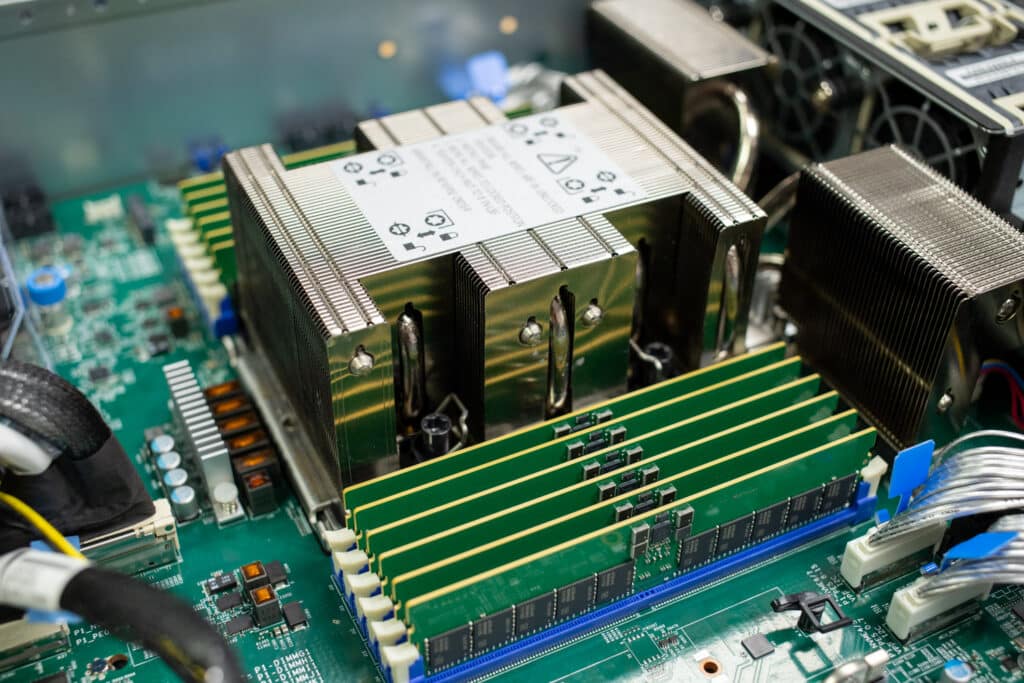
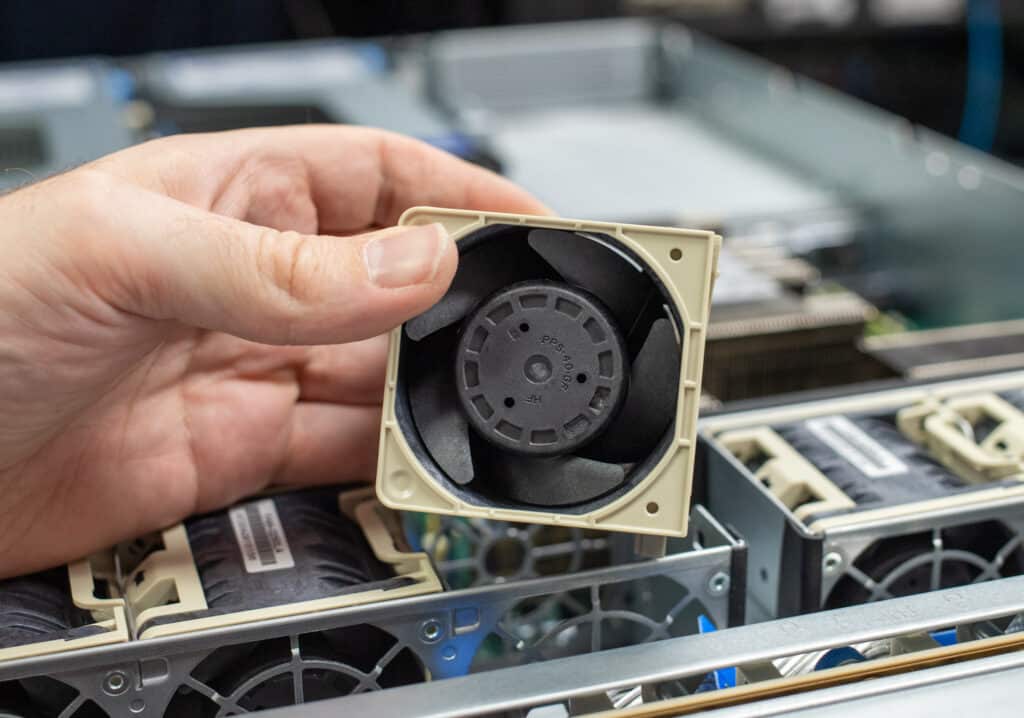
Supermicro Intelligent Management
This chassis features Supermicro’s Intelligent Management BMC interface, powered by an Aspeed AST2600 with 4GB DDR4 RAM. It includes a 1G Ethernet port for remote management, offering system monitoring, firmware updates, and KVM functionality, even when the system is powered off. This setup ensures efficient and reliable server administration, which is ideal for enterprise environments.
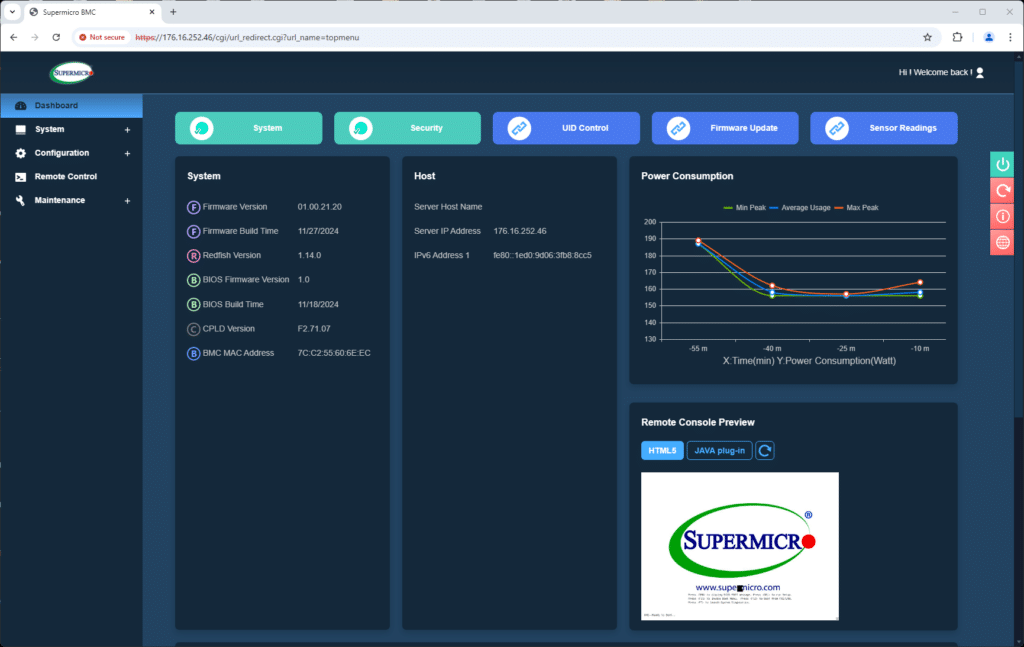
Supermicro Intelligent Management: Web Dashboard
The dashboard provides an overview of all essential server information, including details about the host, system, power consumption, and remote console access. On the side pane, you’ll find power controls for managing the unit, allowing for easy adjustments and monitoring of the server’s power status.
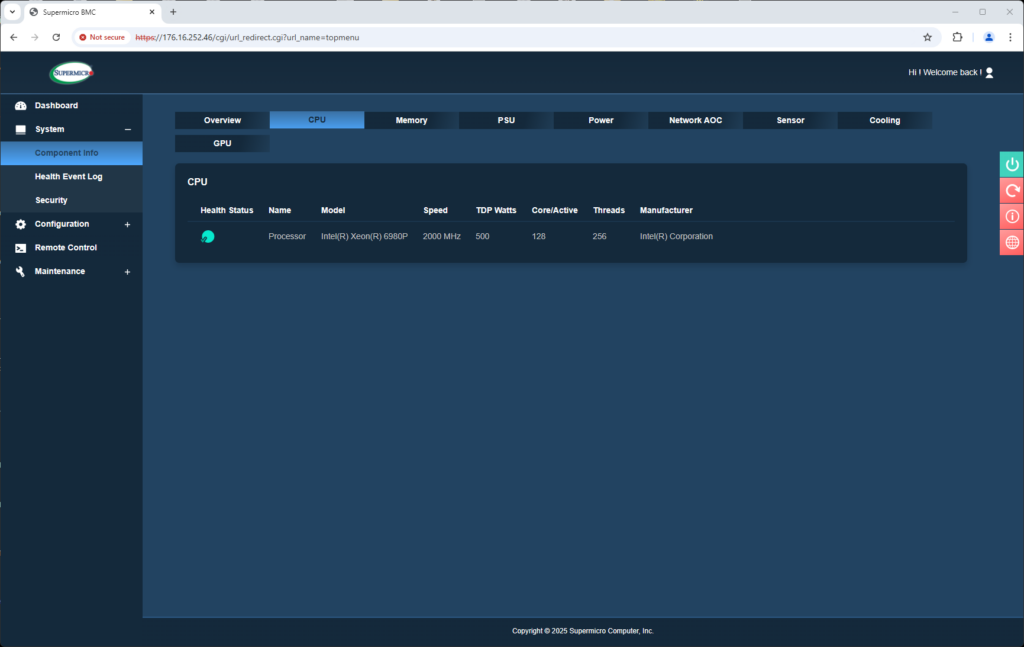
Component Info: CPU
The Component Info section provides a detailed view of the server’s current configuration and health status, including the CPU, memory, power supply units (PSUs), power usage, add-on network cards, sensors, cooling systems, and GPUs This allows customers to monitor the system’s overall performance and detect any potential issues.
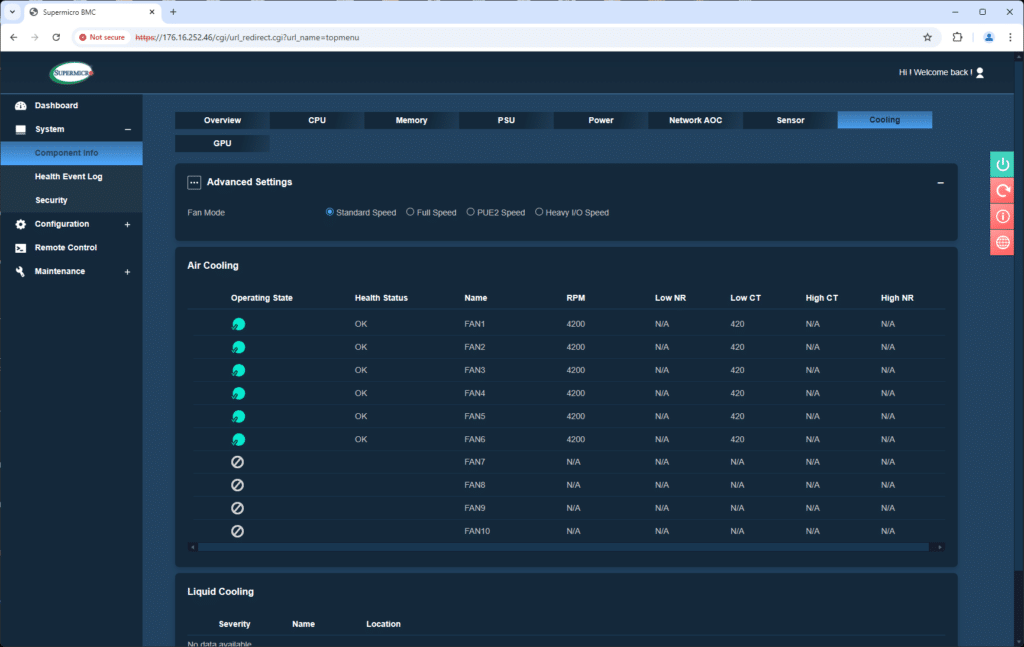
Component Info: Cooling
In addition to the Component Info, the Cooling section allows you to adjust the server’s fan profile, providing control over the fan speeds to optimize cooling performance based on the system’s needs.
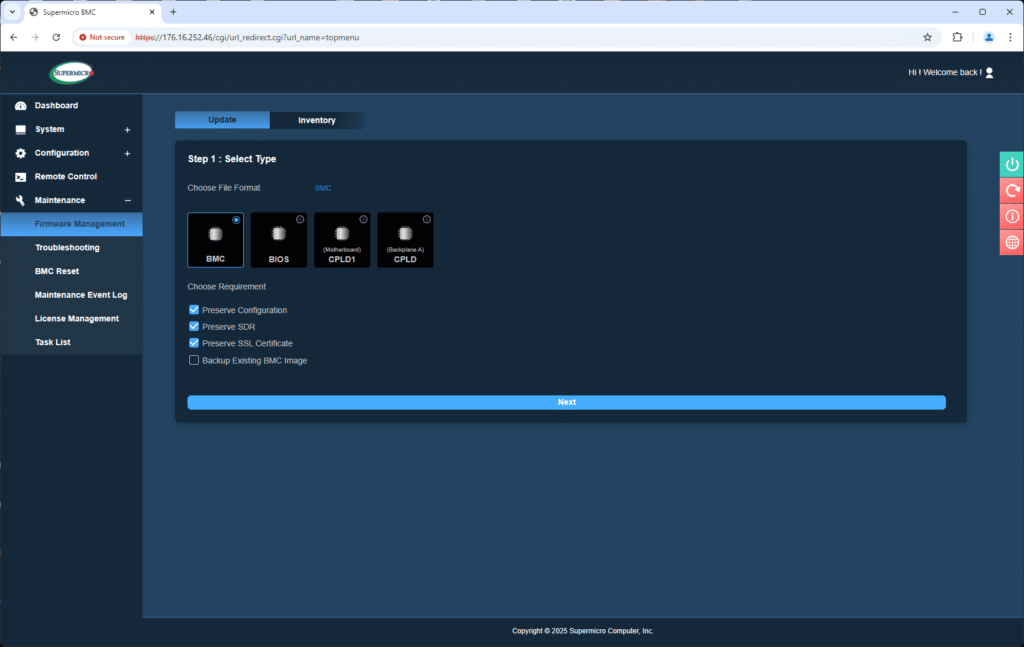
Maintenance: Firmware Management
In the Firmware Management section under the Maintenance pane, two key features are available: the Update Section, where you can choose the type of update (BMC or BIOS) and options to back up old images or preserve configurations, and the Inventory Pane, which shows the current firmware versions of the server. This makes it easy to track and verify the versions in use.
Remote Control: section with HTML5 or JAVA plug-inFor remote management, the BMC uses HTML5 or Java plug-in, with an option to configure the mouse mode for optimal performance based on the installed operating system. This is also where you can reset the IKVM if needed.
Supermicro Hyper SuperServer SYS-212HA-TN Performance
This is our first Intel Granite Rapids server, so we positioned it against the Sierra Forest platforms previously tested in the lab to illustrate the differences in CPU performance. Comparable platforms offer the Sierra Forest Xeon 6780E CPU with 144 E-cores, which targets more cost-optimized workloads. These might be areas where customers were looking to replace dated platforms without a significant performance increase. In contrast, the Granite Rapids Xeon 6980P CPU with 128 P-cores targets higher-performance workloads.
Supermicro Hyper SuperServer SYS-212HA-TN
- CPU: 1x Intel Xeon 6980P (128-core)
- RAM: 384GB DDR5
- SSD: Micron 7450 NVMe Datacenter SSD
- Operating System: Server 2025
Lenovo ThinkSystem SR630 V4 Configuration
- CPU: 2 x Intel Xeon 6780E (144-core)
- RAM: 512GB DDR5
- SSD: Samsung MZWL6960HFJA-00AW7
- Operating System: Server 2025
Supermicro Hyper 1U SYS-112H-TN Configuration
- CPU: 1x Intel Xeon 6780E (144-core)
- RAM: 512GB DDR5
- SSD: Micron 7450 NVMe Datacenter SSD
- Operating System: Server 2022
Blender OptiX
First up is the Blender test, an open-source 3D modeling application. This benchmark was run using the Blender Benchmark utility. The score is samples per minute, with higher being better.
The Lenovo ThinkSystem SR630 V4 excelled with Blender 4.2, delivering 1,432 samples per minute in the Monster scene. The Supermicro SYS-212HA-TN achieved 1,134, and the Supermicro SYS-112H-TNRT (running Blender 4.0) reached 781. Lenovo reported 915 samples in the Junkshop scene, with the Supermicro SYS-212HA-TN following at 759 and the SYS-112H-TNRT at 515. In the Classroom scene, Lenovo led with 657 samples, the SYS-212HA-TN delivered 540, and the SYS-112H-TNRT trailed at 371.
| Blender CPU Benchmark | Supermicro Hyper 1U 112H-TN (1x Xeon 6780E, 512GB DDR5) | Lenovo ThinkSystem SR630 V4 (2x Intel Xeon 6780E, 512GB) | Hyper SuperServer SYS-212HA-TN (1x Intel Xeon 6980P, 384GB RAM) |
|---|---|---|---|
| Monster (Blender 4.0/4.2) | 781.42 | 1432.09 | 1134.77 |
| Junkshop (Blender 4.0/4.2) | 514.658 | 914.75 | 758.65 |
| Classroom (Blender 4.0/4.2) | 370.52 | 656.68 | 540.47 |
y-cruncher
y-cruncher is a popular benchmarking and stress-testing application that launched back in 2009. This test is multi-threaded and scalable, computing Pi and other constants up to the trillions of digits. Faster is better in this test. This software has been fantastic at testing high-core count platforms and showing compute advantages between single and dual-socket platforms.
The y-cruncher benchmark underscores the stark performance differences between the Granite Rapids and Sierra Forest CPUs, particularly highlighting the role of CPU architecture and core design. The Supermicro SYS-212HA-TN, equipped with the 128-core Intel Xeon 6980P (P-Core-based), consistently outperformed its competitors, excelling in high-digit computations. The Lenovo ThinkSystem SR630 V4, with dual 144-core Intel Xeon 6780E CPUs (E-Core-based), provided strong results but lagged behind the SYS-212HA-TN. The Supermicro SYS-112H-TNRT, featuring a single Xeon 6780E, was disadvantaged due to its single-CPU configuration.
| y-cruncher (0.8.5.9) (Lower is better) | Supermicro Hyper 1U 112H-TN (Xeon 6780E, 512GB DDR5) | Lenovo ThinkSystem SR630 V4 (2 x Intel Xeon 6780E, 512GB) | Hyper SuperServer SYS-212HA-TN (1x Intel Xeon 6980P , 384GB RAM) |
|---|---|---|---|
| 1 Billion | 8.757 seconds | 5.997 seconds | 2.965 seconds |
| 2.5 Billion | 24.928 seconds | 17.573 seconds | 8.081 seconds |
| 5 Billion | 53.489 seconds | 37.793 seconds | 17.650 seconds |
| 10 Billion | 113.727 seconds | 81.046 seconds | 38.170 seconds |
| 25 Billion | 308.218 seconds | 220.025 seconds | 108.123 seconds |
| 50 Billion | 674.299 seconds | 476.826 seconds | 238.4429 seconds |
Geekbench 6
Geekbench 6 is a cross-platform benchmark that measures overall system performance. The Geekbench Browser allows you to compare any system to it.
Lenovo’s single-core performance scored 1,173, while the single-processor Supermicro SYS-112H-TNRT achieved 1,154, showcasing the Xeon 6780E’s efficiency in single-threaded workloads. Meanwhile, the Supermicro SYS-212HA-TN, equipped with the Xeon 6980P, led with a 2,059 score, leveraging its P-Cores for exceptional single-threaded performance.
In the multi-core test, the SYS-112H-TNRT scored 15,167, narrowly outperforming the SYS-212HA-TN at 15,055, while the dual-socket Lenovo ThinkSystem SR630 V4 scored 13,868. Geekbench struggled to fully scale with the SR630 V4’s 288 E-Cores. This bottleneck highlights the limitations of certain applications when faced with high core counts.
| Geekbench 6 (Higher is better) | Supermicro Hyper 1U 112H-TN (Xeon 6780E, 512GB DDR5) | Lenovo ThinkSystem SR630 V4 (2 x Intel Xeon 6780E, 512GB) | Hyper SuperServer SYS-212HA-TN (1x Intel Xeon 6980P, 384GB RAM) |
|---|---|---|---|
| CPU Single-Core | 1,154 | 1,173 | 2,059 |
| CPU Multi-Core | 15,167 | 13,868 | 15,055 |
Cinebench R23
The Cinebench R23 benchmark tool evaluates a system’s CPU performance by rendering a complex 3D scene using the Cinema 4D engine. It measures single-core and multi-core performance, providing a comprehensive view of the CPU’s capabilities in handling 3D rendering tasks.
The table below highlights the results of the Cinebench R23 benchmark. The Lenovo ThinkSystem SR630 V4 excelled in multi-core and single-core performance, scoring 99,266 and 894 points, respectively. The Supermicro SYS-112H-TNRT performed admirably with 92,516 multi-core and 888 single-core points, demonstrating strong efficiency with a single Xeon 6780E. The Supermicro SYS-212HA-TN, powered by the 128-core Xeon 6980P, achieved 76,617 multi-core and 1,479 single-core points, showcasing its exceptional single-threaded performance.
| Cinebench R23 | Supermicro Hyper 1U 112H-TN (Xeon 6780E, 512GB DDR5) | Lenovo ThinkSystem SR630 V4 (2 x Intel Xeon 6780E, 512GB) | Hyper SuperServer SYS-212HA-TN (1x Intel Xeon 6980P, 384GB RAM) |
|---|---|---|---|
| CPU Multi-Core | 92,516 pts | 99,266 pts | 76,617 pts |
| CPU Single-Core | 888 pts | 894 pts | 1,479 pts |
| MP Ratio | 104.20 x | 111.00 x | 51.79 x |
Cinebench 2024
Cinebench 2024 extends R23’s benchmark capabilities by adding GPU performance evaluation. It continues to test CPU performance but also includes tests that measure the GPU’s ability to handle rendering tasks.
The table below highlights the results of the Cinebench 2024 benchmark. The Lenovo ThinkSystem SR630 V4, equipped with dual Xeon 6780E processors, scored 2,884 points in the multi-core test, while the Supermicro SYS-112H-TNRT, also running a single Xeon 6780E, recorded 2,565 points. Both systems delivered 53 points in the single-core test, reflecting similar per-core performance.
The Supermicro SYS-212HA-TN, powered by a single Xeon 6980P with a high P-Core count of 128, delivered 6,078 points in the multi-core test. This system also excelled in single-core performance, achieving 87 points, benefiting from the enhanced architecture and high-frequency P-Cores of the 6980P. Its multi-core performance scaling resulted in an MP Ratio of 69.69x, significantly outperforming the 54.43x ratio of the Lenovo and 48.38x of the Supermicro SYS-112H-TNRT.
Again, this highlights the advantage of the Xeon 6980P’s high P-Core count, allowing the Supermicro SYS-212HA-TN to outperform the dual-CPU configuration of the Lenovo Think System SR630 V4 and the single-processor Supermicro SYS-112H-TNRT in multi-core and single-core benchmarks.
| Cinebench R24 | Supermicro Hyper 1U 112H-TN (Xeon 6780E, 512GB DDR5) | Lenovo ThinkSystem SR630 V4 (2 x Intel Xeon 6780E, 512GB) | Hyper SuperServer SYS-212HA-TN (1x Intel Xeon 6980P, 384GB RAM) |
|---|---|---|---|
| CPU Multi-Core | 2,565 pts | 2,884 pts | 6,078 pts |
| CPU Single-Core | 53 pts | 53 pts | 87 pts |
| MP Ratio | 48.38 x | 54.43 x | 69.69 x |
Blackmagic RAW Speed Test
The Blackmagic RAW Speed Test is a performance benchmarking tool designed to measure a system’s capabilities in handling video playback and editing using the Blackmagic RAW codec. It evaluates how well a system can decode and play back high-resolution video files, providing frame rates for both CPU- and GPU-based processing.
The Supermicro SYS-212HA-TN outperformed the Think System SR630 V4 and Supermicro SYS-112H-TNRT with a total score of 148 FPS.
| Blackmagic RAW Speed Test (higher is better) | Supermicro Hyper 1U 112H-TN (Xeon 6780E, 512GB DDR5) | Lenovo ThinkSystem SR630 V4 (2 x Intel Xeon 6780E, 512GB) | Hyper SuperServer SYS-212HA-TN (1x Intel Xeon 6980P, 384GB RAM) |
|---|---|---|---|
| FPS CPU | 116 FPS | 120 FPS | 148 FPS |
7-Zip
The popular 7-Zip utility’s built-in memory benchmark measures the performance of a system’s CPU and memory during compression and decompression tasks, indicating how well the system can handle data-intensive operations.
key Results (Higher is Better)
- Compression Performance: The SYS-212HA-TN achieves a resulting compression rating of 302.712 GIPS, significantly outperforming the other systems Lenovo SR630: 224.313 GIPS, Supermicro 1U 112H-TN: 245.823 GIPS.
- Decompression Performance: The SYS-212HA-TN almost ties with the Lenovo SR630 in decompression, with a resulting rating of 287.823 GIPS, though closely followed by the Lenovo SR630 288.457 GIPS, with the Supermicro 1U 112H-TN trailing behind at 269.373 GIPS.
- Total Performance: Overall, the SYS-212HA-TN registers a total rating of 295.268 GIPS, outperforming both the Lenovo SR630 256.385 GIPS and the Supermicro 1U 112H-TN 257.598 GIPS.
| 7-Zip Compression & Decompression | Supermicro Hyper 1U 112H-TN (Xeon 6780E, 512GB DDR5) | Lenovo ThinkSystem SR630 V4 (Intel Xeon 6780E, 512GB) | Hyper SuperServer SYS-212HA-TN (1x Intel Xeon 6980P, 384GB RAM) |
|---|---|---|---|
| Compressing – Current CPU Usage | 5287% | 5064% | 5300% |
| Compressing – Current Rating/Usage | 4.647 GIPS | 4.341 GIPS | 5.795 GIPS |
| Compressing – Current Rating | 245.699 GIPS | 219.840 GIPS | 307.117 GIPS |
| Compressing – Resulting CPU Usage | 5296% | 5156% | 5214% |
| Compressing – Resulting Rating/Usage | 4.642 GIPS | 4.350 GIPS | 5.806 GIPS |
| Compressing – Resulting Rating | 245.823 GIPS | 224.313 GIPS | 302.712 GIPS |
| Decompressing – Current CPU Usage | 6236% | 6184% | 6195% |
| Decompressing – Current Rating/Usage | 4.261 GIPS | 4.688 GIPS | 4.703 GIPS |
| Decompressing – Current Rating | 265.709 GIPS | 289.879 GIPS | 291.363 GIPS |
| Decompressing – Resulting CPU Usage | 6236% | 6205% | 6133% |
| Decompressing – Resulting Rating/Usage | 4.341 GIPS | 4.649 GIPS | 4.693 GIPS |
| Decompressing – Resulting Rating | 269.373 GIPS | 288.457 GIPS | 287.823 GIPS |
| Total – Total CPU Usage | 5751% | 5681% | 5674% |
| Total – Total Rating/Usage | 4.491 GIPS | 4.500 GIPS | 5.250 GIPS |
| Total – Total Rating | 257.598 GIPS | 256.385 GIPS | 295.268 GIPS |
Conclusion
This is the first P-core system we’ve gotten our hands on, and the Supermicro Hyper SuperServer SYS-212HA-TN impresses with its Intel Xeon 6th Generation (Granite Rapids) processors, including the 128-core 6980P all P-core processor, delivering 3.906W per core. This server is designed to handle demanding workloads like virtualization, AI inference, machine learning, and cloud computing.
Equipped with multiple PCIe 5.0 slots, including an OCP 3.0 compatible PCIe 5.0 x16 AIOM slot for networking, it offers scalable connectivity for GPUs, add-on cards, and other expansion components. Its high-density storage and database processing capabilities make it a strong choice for storage-intensive applications.

When drilling into performance, you can see the stark contrast between the Intel Sierra Forest E-Core and Intel Granite Rapids P-Core CPUs. While the E-core units can vastly outperform the P-core units in raw core count, single-threaded performance doesn’t compete near the same level. In our y-cruncher workload, looking at raw compute performance, the single-socket 6980P CPU ran laps around the single- or dual-socket 6780E configurations. This gives the Hyper SuperServer SYS-212HA-TN incredible potential when targeting compute-heavy workloads, even with a single CPU.
With its powerful performance and flexibility, the Supermicro Hyper SuperServer SYS-212HA-TN is an excellent single-processor solution for enterprises and data centers looking for a high-performance, scalable server to handle complex workloads. Additionally, this system packs a punch compared to the single and dual-socket 144-core 6780E (Sierra Forest) systems, providing a competitive edge for workloads that can benefit from the extra power.


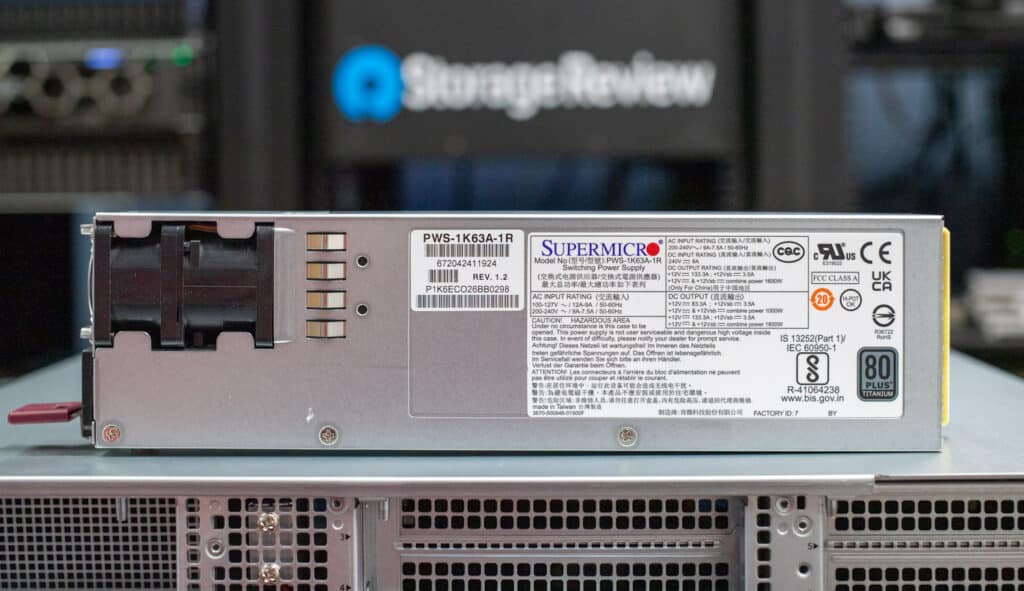
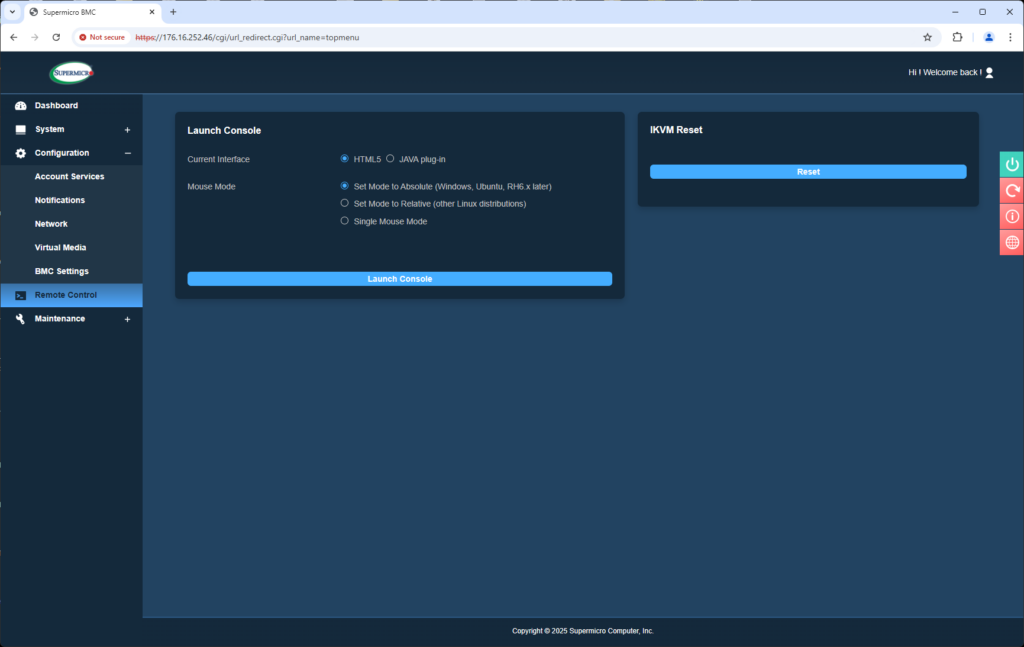


 Amazon
Amazon